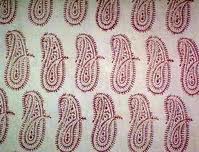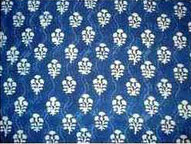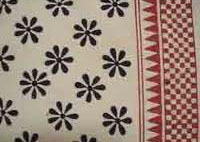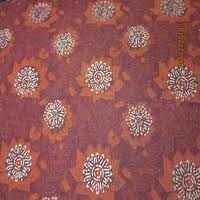The Bagru Print

The traditional ‘motifs’ of Bagru have however under gone change over the years. The entire population of ‘chhipas’ which were earlier engaged in production of all local varieties of printed fabrics mostly of ‘fadats,indigo fabric’, ‘angochha’ (small towel), ‘bichhauni’ (bed spread), rajai (quilt) are now engaged in production of sophisticated ‘ kaftans’ ‘wraparounds’ (skirts), ‘midis’ etc. All the same, basic techniques and colours have remained unchanged and unaffected through these centuries, this makes the Bagru prints spectacularly different, distinctive and highly specialized.The local people, particularly the women folk, mainly used the Bagru prints in the past. Patterns in rich colours like the indigo blue, alizarin, iron block and bright yellow were produced on coarse cotton cloth by indigenous processed of dyeing and printing. In building up patterns, geometrical forms were adopted along with floral, animal and bird forms. Everything seemed to be inspired from local sources. Synthetic dyed have now replaced some natural dyes but their ‘resists, and their application and processed and their sequences have hardly under gone any change. The styles and motifs have been adapted to some extent to the changing market pattern.
The Syahi-Begar prints are a combination of black and yellow ochre or cream. The Dabu prints are created by hiding them from dye, by applying a resist. Bagru prints are characterized by circular designs, as well as linear and floral patterns.In both the Sanganer and Bagru prints, the colors are picked carefully. Each has a separate significance. For instance, red is the color of love, yellow of spring, indigo of Lord Krishna, and saffron of the yogi (seer). The wooden blocks that are used are made of teak wood.Traditionally,vegetable dyes made of madder, pomegranate rind, indigo, and turmeric are used. These have now been largely replaced by chemical dyes. Often, the fabric is dyed before it is printed.
- Colors
- Difference:Sanganeri & Bagru
- Traditional Designs

Bagru prints are done on off-white, ivory white or beige background. The main colors used in Bagru printing are black, red and maroon. These three main colors are extracted from naturally occurring sources: black is derived from worn-out iron horse or camel shoes soaked in water, red comes from gum paste and phitkari, and maroon is a result of mixing the above two colors.Apart from these base colors, natural vegetable dyes are used to add colorful patters and designs. These include madder, indigo, pomegranate rind, turmeric, etc. Pigment colors such as green, rust, blue, violet, brown, and pink are added to appease wider markets. There is also a traditional reason for picking a particular color in the designs, such as indigo for Lord Krishna, saffron for a saint or yogi, yellow for spring season, etc.
The main distinguishing feature between Sanganer and Bagru printing is that Sanganer print is usually done on a white ground, whereas Bagru prints are on an Indigo or a dyed background. Local water also has its effects. In Sanganer water, block comes out in its best dark shade, while at Bagru block comes with a reddish tinge. As water has always been abundant in Sanganer, the washing of cloth has formed the main basis of printing and dyeing there. In Bagru, where water is comparatively scarce, ‘Dhabu’ resist printing and indigo work is mostly done.
Difference in motifs-Traditionally, motifs printed at Bagru are large with bold line, as compared to sanganer, where somber colours and fine lines, intricate detailing are practiced. Sanganeri motifs are naturalistically rendered, with motifs usually based on flowers i.e. iris, rose, poppy, marigold, sunflower, chrysanthemum etc. Bagru motifs are more geometric than the sanganeri motifs.
The patterns or designs/motifs which are traditionally made in Rajasthan can be classified as ‘boota’, bootie’ and ‘jal’.
‘Boota’: ‘Boota’ is normally referred to as design which is single and complete in itself. The word ‘boota’ is derived from the Persian word ‘Butteh’ which means complete tree. ‘Bootas’ depict the flora and fauna of the region and sometimes birds are also seen. Since it is a single unit the spacing between the two impressions can be varied normally a ‘boota’ is not bigger than 3”x5”.
‘Booti’: ‘Booti’ is a smaller form of ‘boota’ and the spacing between one ‘booti’ and another is predetermined. There could be up to 20 booties on one block *, depending on the size and space, Like ‘boota’ most of the ‘booties’ depict the flora and fauna and birds of the area. Sometimes the geometric forms like dots, circles, squares and lines are also used. Sanganeri ‘booties’ are classic, decorative delicate, refined and exquisite, which were basically used for royal families of Jaipur for clothing, whereas booties from Bagru are slightly folk.
‘Jaal’: ‘Jaal’ is pattern, which gives continuous interconnection surface. ‘Jaals’ were not very popular in Sanganeri prints but other centres have ‘Jaal;’ Patterns which are floral, paisley (‘keri’) and geometric. Narrow borders of 2”-4” width are also used in all the centers. The designs are similar to ‘booties’ in form and decoration.
The Bagru
Jaipur is perhaps one of the most culturally rich areas of Rajasthan. Bagru, a small village town in Rajasthan is situated at a distance of 32ksm east of Jaipur. It is known for its traditional processed of hand block printing of textile.  The ‘chhipas’ of Bagru have assembled here from Sawai Madhopur, Alwar, Junjjhunu and Sikar districts of Rajsthan to settle in Bagru and make it their home some 300 years ago. They made it their home, and one of Rajasthan's most important centers of hand block printining.Bagru is derived from the word’ Bagora’ the name of an island in a lake where the city was originally built and is famous for its palm fan and ‘chintz’ (fadat) production pattern.
The ‘chhipas’ of Bagru have assembled here from Sawai Madhopur, Alwar, Junjjhunu and Sikar districts of Rajsthan to settle in Bagru and make it their home some 300 years ago. They made it their home, and one of Rajasthan's most important centers of hand block printining.Bagru is derived from the word’ Bagora’ the name of an island in a lake where the city was originally built and is famous for its palm fan and ‘chintz’ (fadat) production pattern.
The Sanganer
Sanganer is situated about 8 kilometers south-east of Jaipur city. Prior to the 17th century, there is no mention of Sanganer as a centre of printing. At that time Sanganer was known as a centre of plain and dyed clothes. It was probably towards the end of the 17th century that this art  form developed here. Probably due to war with Emperor Auranngzeb and the repeated invasions of the Marathas, many craftsmen (Printers) from the neighboring state Gujarat came and settled in Rajasthan. By the end of the 18th century this industry was fully developed in Sanganer. It is famous for dyeing and printing of colorful dresses, bed sheets, curtains, dress material and variety of other textiles. Bulk of the textile products of these industries is exported. The total area of Sanganer is about 635.5 Sq. km out of which, 12.9 Sq. km comprises the urban area.
form developed here. Probably due to war with Emperor Auranngzeb and the repeated invasions of the Marathas, many craftsmen (Printers) from the neighboring state Gujarat came and settled in Rajasthan. By the end of the 18th century this industry was fully developed in Sanganer. It is famous for dyeing and printing of colorful dresses, bed sheets, curtains, dress material and variety of other textiles. Bulk of the textile products of these industries is exported. The total area of Sanganer is about 635.5 Sq. km out of which, 12.9 Sq. km comprises the urban area.
Traditional Printing process in Sanganer and Bagru
The traditional printing process in sanganer and Bagru can be described as follows:
Scouring- locally called ‘Hari Sarana’
The fabric that comes from mills of handloom sector contains natural and added impurities such as starch, oil and dust. To get goods and even penetration of colours, the fabric is boiled with soap and desizing agents. Traditionally cow dung was used for scouring. Cow dung contains a lot of alkali, Cow dung and water are mixed together and the cloth (running cloth ‘than’cut in required length) is then left dipped in that paste overnight. The process of washing is a long one, generally carried out by the ladies. The next day, the clothes are washed and spread on large open grounds. Before the clothes dry completely, more water is sprinkled on them and thus they are made wet again. This process of sprinkling water and drying is repeated 5-6 times a day. This procedure is carried out unit the cloth becomes white and bright. Generally, as per requirement, this process in done for 3 to 6 days. After this the cloth is washed with pure water. Since it is tedious and time consuming, soaps have replaced the cow dung in this process.
Tannin- locally called ‘Peela Karana’
‘Harda’Washed fabric is treated with myrobalan (harda) which contains tannic acid. Tannic acid attracts the mordants, which are applied with hand woodblock. ‘Harda’ powder is mixed with water, and the cloth is submerged in it, squeezed and dried flat on the ground. Once the fabric is dried, it is folded and beaten with a wooden mallet to remove excess ‘harda’ powder and open up the fiber to accept the dye. This process in known as ‘peela karna’. The tannic acid of myrobalam (harda) forms black colour with ferrous ( syahee )which is traditionally made by reaction of old rusted horse shoe nails with jaggery.
Printing (mordanting)- locally called ‘chapai’
The fabric is printed with two mordant- ferrous (‘syahee’) made out of rusted horse shoe nails, and alum (‘begar’). Usually ferrous is printed with the outline block (‘rekh’). As it immediately shows a black impression, it is easy for another printer to place the filler block (‘datta’) with beggar or alum. The background block (Gudh’) comes later.
Ageing-locally called ‘Sukhai’
The printed fabric is left hanging at the printing areas for at least three-four days so that the prints(mordant paste) penetrates into the fiber structure. Longer the ageing better is the result.
Washing- locally called ‘Dhulai’
The printed fabric is washed in running water. It is important to understand the need of running/flowing water. While washing the printed fabric in running water the excess mordants come out and get washed away with the flow of water without getting stuck back to the cloth. Water shortage has forced the printers to cut short this process due to which, the colors do not get fixed up properly and later “bleed” and people think that natural dyes are not fast.
Dyeing (fixing of color) - locally called ‘Ghan Rangai’
Dyeing is a process in which the dye reacts with two mordants at two different locations on the same print giving two different shades of colors. As mentioned earlier ‘alizarin’ is used as the dye throughout Rajasthan. The colours obtained in conjunction with the two mordants are red (with alum) and block (with ferrous). Dyeing is carried out in large copper vessels (‘tambri’) which are heated by wood fire. Alizarin is filled in small cloth-bags (‘potali’) and dipped in the vessel. The quantity of alizarin dye is calculated by the experienced dyer. ‘Dhawadi phool’, a local flower is boiled along with alizarin to avoid patches and staining. Once the dyed fabric is ready (usually it takes half-an-hour), it is taken out of the copper vessel and left on the ground for drying.
Sun-bleaching- locally called ‘Tapai’
Alizarin often”over dyes” the unprinted area giving an off-white or yellow tinge all over the fabric which makes the print look dull. In order to make the ground look ‘white’ again the fabric is sun-bleached. In this process the fabric is laid flat on a river bed, a mild solution of cow dung and water is sprinkled over the fabric. This process is repeated again when the fabric is dried. The interaction of alkali (of cow dung) and thermal heat (sun ray) bleach the ground color making it look white again. Sometimes this process in carried out before the tannin (‘harda’) treatment but due to shortage of water this process is cut short and these days the ‘off- white’ color of the background has become a part of natural dyeing process.



 The ‘chhipas’ of Bagru have assembled here from Sawai Madhopur, Alwar, Junjjhunu and Sikar districts of Rajsthan to settle in Bagru and make it their home some 300 years ago. They made it their home, and one of Rajasthan's most important centers of hand block printining.Bagru is derived from the word’ Bagora’ the name of an island in a lake where the city was originally built and is famous for its palm fan and ‘chintz’ (fadat) production pattern.
The ‘chhipas’ of Bagru have assembled here from Sawai Madhopur, Alwar, Junjjhunu and Sikar districts of Rajsthan to settle in Bagru and make it their home some 300 years ago. They made it their home, and one of Rajasthan's most important centers of hand block printining.Bagru is derived from the word’ Bagora’ the name of an island in a lake where the city was originally built and is famous for its palm fan and ‘chintz’ (fadat) production pattern.  form developed here. Probably due to war with Emperor Auranngzeb and the repeated invasions of the Marathas, many craftsmen (Printers) from the neighboring state Gujarat came and settled in Rajasthan. By the end of the 18th century this industry was fully developed in Sanganer. It is famous for dyeing and printing of colorful dresses, bed sheets, curtains, dress material and variety of other textiles. Bulk of the textile products of these industries is exported. The total area of Sanganer is about 635.5 Sq. km out of which, 12.9 Sq. km comprises the urban area.
form developed here. Probably due to war with Emperor Auranngzeb and the repeated invasions of the Marathas, many craftsmen (Printers) from the neighboring state Gujarat came and settled in Rajasthan. By the end of the 18th century this industry was fully developed in Sanganer. It is famous for dyeing and printing of colorful dresses, bed sheets, curtains, dress material and variety of other textiles. Bulk of the textile products of these industries is exported. The total area of Sanganer is about 635.5 Sq. km out of which, 12.9 Sq. km comprises the urban area.